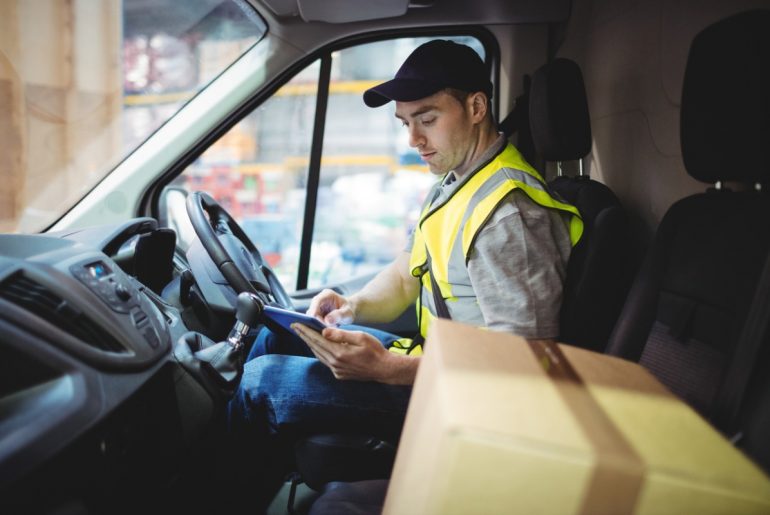While contactless delivery may have gained traction in 2020 primarily due to the unique circumstances created by the pandemic, changes in those circumstances aren’t likely to reduce demand for no-contact delivery. Consumers have grown accustomed to the ease and convenience of receiving their parcels, packages, and even their meals without the need for additional interaction on their end. That convenience is sure to be the new normal in delivery and logistics moving forward.
Whether you’re already providing your customers with contactless delivery options or are looking to add this feature to your offerings moving forward, taking the time to consider every step of the contactless delivery process will allow for happier customers, more efficient drivers, and a safer environment for both parties.
Lasting Demand for Contactless Delivery
E-commerce has been on a steady rise for nearly 20 years, and 2020 was no exception. Safety concerns and stay-at-home orders during the pandemic only led to increases in online ordering during 2020. In the United States alone, e-commerce climbed by more than $70 billion in 2020, reaching $431.6 billion in revenue compared to $369.1 billion in 2019. That number is only expected to keep rising, with projections estimating e-commerce will generate $563.4 billion annually by 2025.
This ongoing shift in customer demand speaks to the expectation of ease and convenience among consumers. These same priorities are the driving force behind the expectation for contactless delivery, so it’s easy to see that contactless delivery is here to stay.
Why Embrace No-Contact Delivery Options?
While customer demand is reason enough to embrace contactless delivery, it’s far from the only benefit for those handling logistics and deliveries. The initial spark that led to the current expectation of contactless delivery options was the reduced likelihood of spreading germs and viruses, and that core idea is as sound now as it was in early 2020. An important factor to remember is that reducing contact by embracing contactless delivery is a two-way street; it’s as beneficial for your drivers as it is for your customers.
Contactless delivery can also be beneficial for your drivers in that it allows them to save time on their routes, ultimately improving both their efficiency and the quality of their workday. Traditional delivery approaches would often leave drivers standing by the door waiting on customers or ringing the doorbell again, resulting in wasted time or even annoyed customers. Contactless delivery makes delivering a package faster and more predictable, allowing your drivers to work more smoothly and deliver more packages during their day.
Taking Steps to Get the Most Out of Contactless Delivery
Providing contactless delivery to your customers is crucial to keeping them satisfied as their expectations continue to increase, but it isn’t enough just to offer a no-contact option. It’s equally important that you take steps to keep customers informed and up-to-date while their delivery is in transit, and there are a number of ways to easily do just that.
Track Deliveries in Real-Time
By using virtual tracking to track your drivers on their routes, you’re able to access up-to-date information on where they are and how they’re moving along their route. This eliminates the need for the back office to text or call drivers who are on the road and allows dispatchers to quickly access the driver location and order status.
Having real-time tracking information available also means that you’ll always know the location of every delivery while it’s in progress, giving you the information you need to keep your customers informed.
Provide Status Updates
When a delivery is going to be dropped off without the need for a customer to come to the door or sign for it, it’s extremely helpful for your customer to have an accurate idea of when it will arrive so that they can plan accordingly. Accurate ETAs also help your customers to feel confident that their delivery is a priority for your drivers.
While it’s fairly common to send a shipping notification to the recipient when a package starts its journey, providing more frequent updates along the way helps to keep your customers better informed. This is doubly important if there are unexpected changes or delays along the way. Consider using software that automates the update process to provide your customers with real-time shipping updates and driver ETAs so that they’re always in the loop or, better yet, provide them with a link to track the progress of their delivery in real-time.
Confirm Delivery
Providing confirmation when a package is delivered has traditionally been done by collecting customer signatures, but demand for contactless delivery has taken precedent. With the right software it’s easy for drivers to take a photo as proof of delivery, have that image associated with the customer’s account, and even share the confirmation photo with the customer automatically.
Automating delivery confirmations is key to customer satisfaction, as some customers aren’t likely to check for a package until they receive confirmation that it’s been delivered. By providing a proof of delivery photo upon completion of the delivery, the benefit is two-fold: your customer receives a notification to go and get their package, and you have a proof of delivery photo on record in case the customer fails to get their package right away and something happens to it in the meantime. This can be extremely helpful in the event that a package is stolen, which is an increasingly common occurrence. A recent study noted that 43% of respondents have had at least one package go missing, so automating the process of taking confirmation photos and sending delivery confirmation messages is beneficial for both you and your customers.
As the transportation and logistics industry continues to embrace contactless delivery in pursuit of customer satisfaction, taking steps to ensure you’re providing customers with frequent, up-to-date information is the key to success. To learn more about how route optimization software can help you track drivers and deliveries and automate the customer update process, explore WorkWave Route Manager today.




